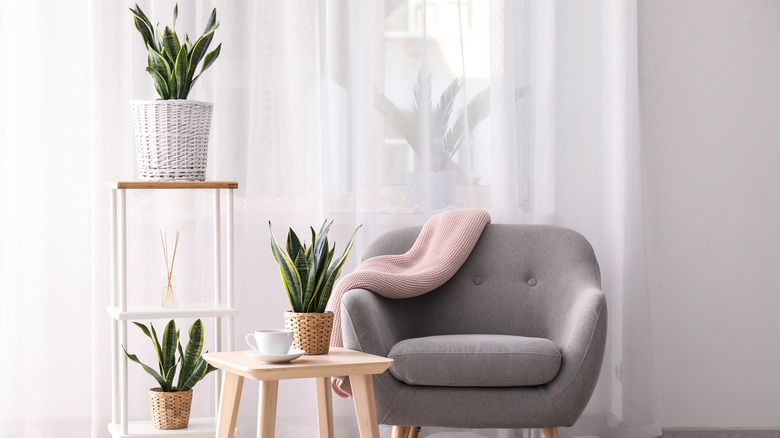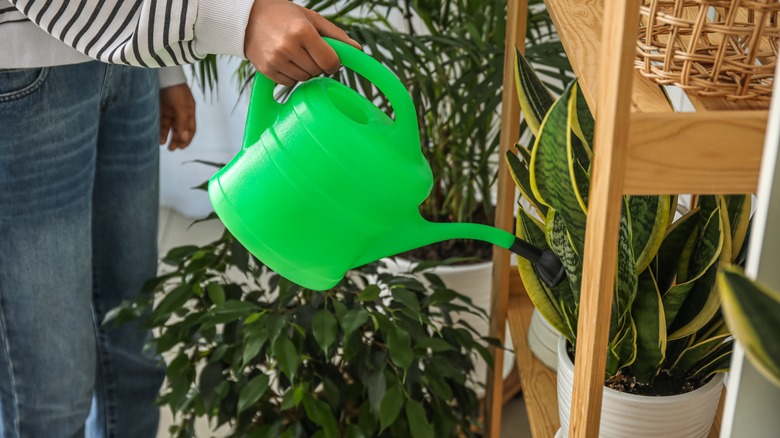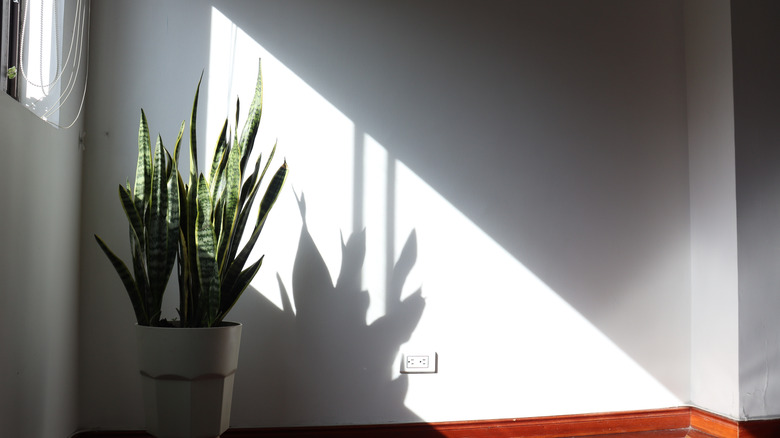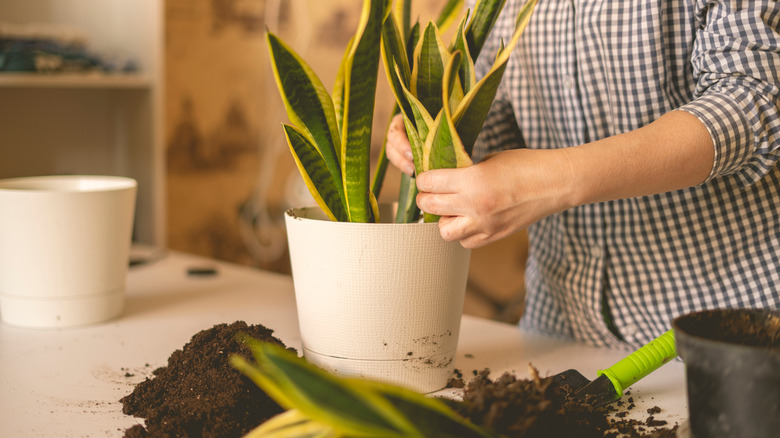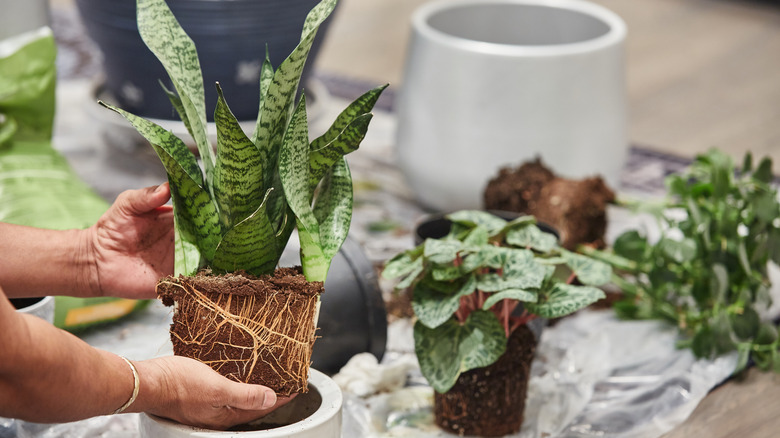Here's Why Your Snake Plant Leaves Are Curling And How To Fix It
Though snake plants are widely regarded as being relatively low-maintenance houseplants, they are not immune to their fair share of issues, particularly if any of their specific growing requirements regarding lighting, water, soil, and temperature are not met. The unique, seaweed-like leaves on the snake plant, or Sansevieria trifasciata, in addition to their somewhat laissez-faire growing nature, make them popular among all types of plant parents.
If there is an issue with your snake plant, one of the first indications will be in the leaves, which may curl either inwards or outwards depending on the specific issue. More often than not, if you notice the leaves on your snake plant beginning to curl, it's usually an indication that it doesn't like something. It could be the soil, the temperature conditions you are trying to grow it in, or it's getting either too much or not enough sunlight and/or water.
Ensuring your snake plant is growing in its preferred conditions and keeping an eye out for other visible issues with your plant that may accompany its curled leaves can help you zero in on exactly what the issue may be.
Improper watering
Snake plants are popular houseplants because they are able to thrive with little water, making them perfect for forgetful plant parents. So while a lack of water can cause dry, curling leaves on your snake plant, overwatering is a much more common reason.
It is their ability to thrive without constant watering that often leads to their overwatering, which is why it's important to remember that your snake plant only needs to be showered with water when the top half of the soil is completely dry. Letting the soil completely dry between waterings prevents too much water from accumulating in the base of the plant, which can lead to nasty issues such as root rot.
In addition to your snake plant leaves beginning to curl, they may also take on a squishy texture or start to yellow, which are all common indications of overwatering. If your plant is drooping, there's a strong odor in the soil and you notice it playing host to tiny, black insects, it's likely your snake plant has fungal rot, meaning you will have to cut off the infected roots before repotting.
While it's often easy to keep track of when you should water your houseplants if you do so on a schedule, watering your snake plant based on the idea that it needs a certain amount of water every few days or weeks can inadvertently cause you to give it more than it needs. Instead, check the soil for moisture. If the soil feels dry, it's time to water.
Improper light
In addition to their low-maintenance watering needs, snake plants are also popular houseplants because, unlike many others, they don't require a full day of direct sunlight. As such, they are able to do well in homes without access to an abundance of all-day natural light. Regardless, snake plants, like any plant, still have their preferred lighting conditions, and if your snake plant's leaves are curling, it's possible that it's getting either too little or too much sunlight.
The leaves of snake plants that receive too little light tend to curl upwards, an indication that they are searching for more sunlight. On the other hand, if a snake plant regularly receives too much sunlight, the speed at which photosynthesis and transpiration occur can increase, which depletes and dehydrates the plant. This can also cause the leaves to curl, while also making them look droopy.
Snake plants prefer a full day of bright, indirect sunlight, or direct sunlight for no more than four to five hours a day. If your snake plant is in a location that doesn't allow for it to receive the right amount of sun on a daily basis, move it to an area that does, such as an east or a west-facing window.
Soil issues
If your snake plant seems to be receiving the right amount of sunlight and water, isn't exposed to any temperature extremes, and its leaves are still curling, it's possible there is an issue with the soil. Though snake plants don't need to be repotted very often — about once every three to five years — if it's been much longer than this and the leaves are curling inward, it's possible the roots have grown and expanded to their full capacity of the pot.
As the roots grow, they utilize nitrogen, depleting the soil of it over time. Repotting in new soil can fix this issue — if it hasn't been long since you have repotted, you can utilize a nitrogen-rich fertilizer to extend the life of the soil.
If you use a fertilizer, be careful not to use more than the recommended amount as noted on the packaging, as too much can throw off the soil's pH level. Snake plants need to grow in soil that has a pH of 5.5 to 7.5. And while they do need nitrogen, using a fertilizer that contains it in excess can make the soil too acidic. When that happens, your snake plant isn't able to get other vital nutrients from the soil, such as magnesium, which is vital in chlorophyll production and photosynthesis. If you have accidentally over-fertilized your snake plant, flush the soil with water for about ten minutes.
Temperature extremes
Similarly to the way they respond to too much or too little light, snake plants do not respond well to temperatures that are too hot or too cold. Snake plants need an environment that is regularly anywhere from 55–85 degrees Fahrenheit to thrive. (That is conveniently right around the temperature that most people likely keep their house year-round.) Straying too far from this temperature range in one direction or the other can cause your snake plant's leaves to curl.
While the mild temperature requirements of the snake plant are another reason it's such a popular houseplant, it's also commonly grown outdoors in climates that rarely stray far from that temperature range. And while this houseplant can make a great landscaping plant, it's important to be mindful of the climate of where you live prior to planting.
If you live in an area where temperatures regularly drop below 50 degrees Fahrenheit during the colder months, your snake plant will likely suffer from cold damage, which can stunt its growth and cause the leaves to curl. Similarly, being exposed to sky-high temperatures outdoors in the summer months can also dehydrate your snake plant, causing the leaves to curl.
If your outdoor snake plant's leaves are curled and you live in an area that sees extreme temperatures on either end, it likely has temperature shock, in which case it's best to keep it indoors as a houseplant. As a houseplant, make sure your snake plant is kept away from heating/cooling elements and vents to avoid potential temperature extremes indoors.
